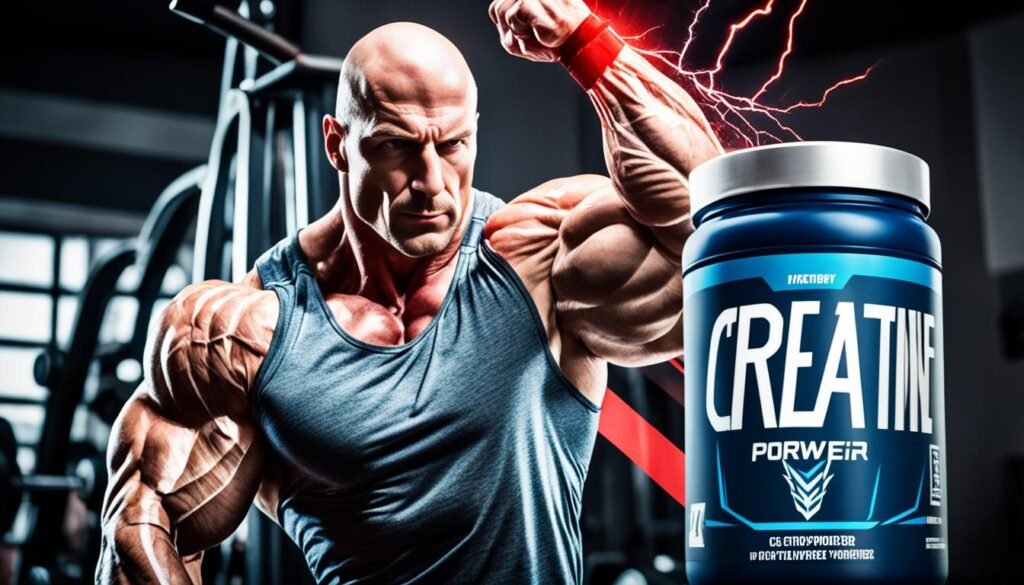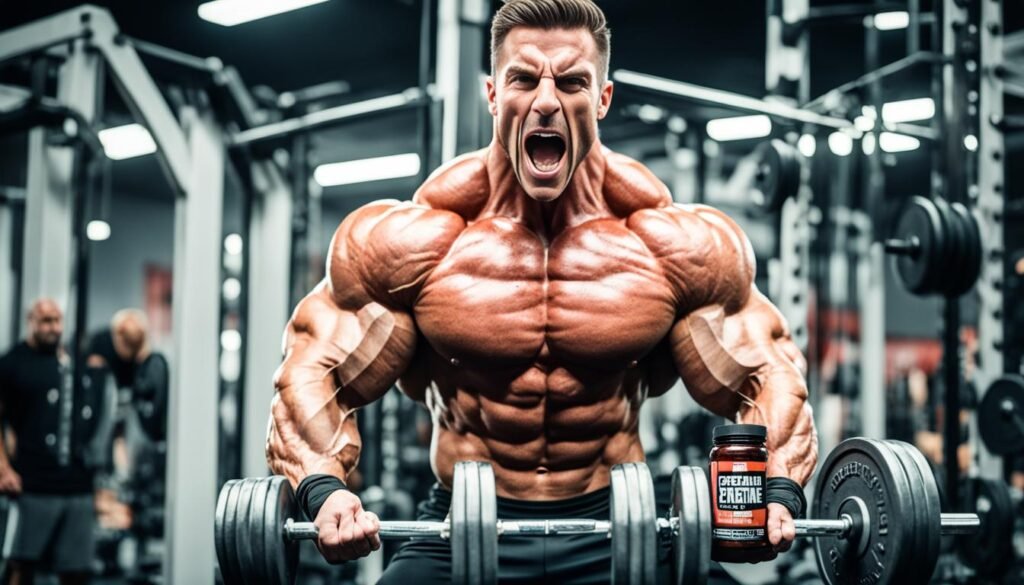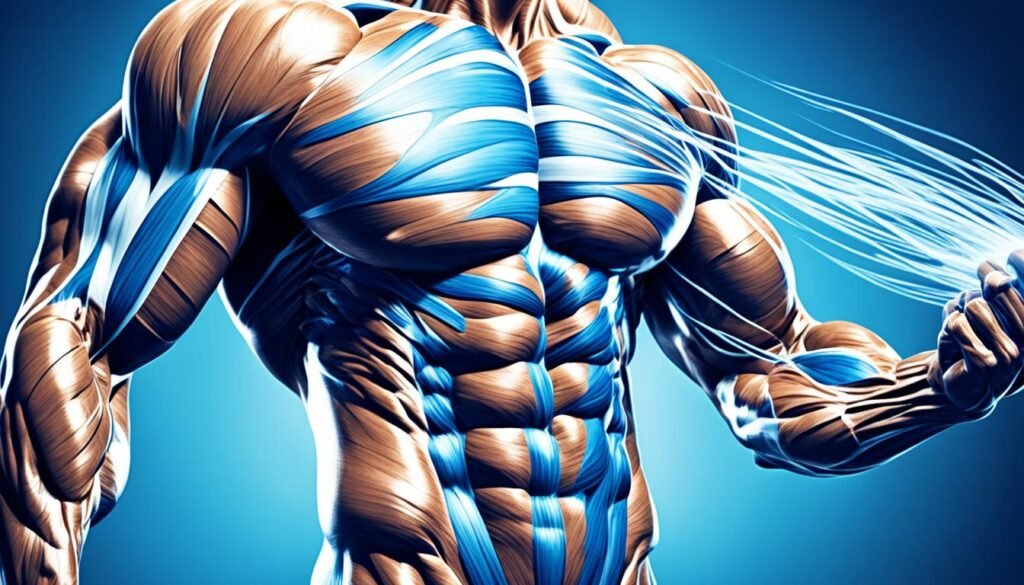Amid the myriad of supplements vying for attention in the bodybuilding world, one has stood out with a staggering presence. Believe it or not, but creatine is synthesized by the human body at a rate of about 1 to 2 grams per day. However, creatine supplementation can increase your muscle stores by up to 40%, underscoring its critical role in enhancing muscle growth and strength training performance. As I delve into the science and strategies behind creatine supplementation, I aim to provide you with a comprehensive guide on how to leverage creatine benefits most effectively.
Whether you’re aiming to break a personal lifting record or simply looking to add lean mass, understanding how to use creatine for muscle growth can be your game-changer. Its well-documented prowess in supporting athletic performance comes from meticulous timing and dosing—not to mention a steadfast commitment to consistency. Let’s explore how you can integrate this power-packed supplement into your regime to optimize your bodybuilding outcomes.
Key Takeaways
- Creatine supplementation can dramatically increase intramuscular creatine levels and enhance strength training results.
- The consistent use of creatine is essential for achieving full muscle saturation and realizing the supplement’s full benefits.
- A creatine loading phase followed by a maintenance phase can quickly elevate muscle creatine stores.
- Alternately, a low-dose daily intake without loading also achieves muscle saturation, albeit over a more extended period.
- Both creatine intake protocols have been shown to significantly improve training productivity and recovery post-exercise.
- The key to maximizing creatine benefits lies in finding the right supplementation strategy that aligns with your fitness goals and regimen.
The Science Behind Creatine and Muscle Growth
Exploring the realm of bodybuilding supplements reveals that creatine stands out due to its scientific backing and proven results. As someone deeply invested in fitness, I recognize that comprehending the nuances of how creatine works can empower users to optimize their gains. Key aspects such as the Creatine loading phase, Creatine cycling, and awareness of possible Creatine side effects are critical for anyone looking to enhance their muscle growth and athletic performance.
Understanding Creatine’s Role in ATP Production
At the cellular level, creatine’s primary role involves the synthesis of adenosine triphosphate (ATP), the energy currency of cells. This biochemical process is especially vital during high-intensity training, as ATP is rapidly consumed. By increasing the phosphocreatine reserves in the muscles, ATP regeneration accelerates, enabling me to push harder for longer during my workouts. It’s this mechanism that underscores the importance of supplementing with creatine to sustain peak muscle performance.
Research on Creatine’s Effectiveness for Strength and Endurance
Scientific studies have repeatedly corroborated the enhancements in strength and endurance associated with creatine supplementation. It’s fascinating to note how creatine loading, a method involving the intake of a higher dose over a brief period, augments intramuscular creatine stores more efficiently than regular maintenance doses. This strategy invariably leads to tangible improvements in maximal-effort activities. Such research findings solidify my conviction in utilizing creatine to reach my full strength potential.
Creatine Supplementation Strategies

As a dedicated enthusiast of bodybuilding and a meticulous experimenter with supplements, I’ve been closely evaluating Creatine monohydrate due to its Creatine benefits, particularly in aiding Creatine for muscle growth. This supplement, lauded for its cost-effectiveness and high absorption rate, has become an integral part of my training regimen. In my journey, I discovered that timing and consistency of Creatine dosage are pivotal to maximizing its potential.
With ample research and trial, here’s the strategy I advocate: individuals should consider a daily intake of 3-5 grams of Creatine. This recommendation holds true whether you choose to kickstart your supplementation with a loading phase or maintain a steady, daily regimen right from the beginning. Below is a table detailing my suggested approach to Creatine supplementation to fully exploit its muscle-enhancing properties:
| Supplementation Method | Loading Phase | Maintenance Phase |
|---|---|---|
| With Loading | 20-25 grams per day, divided into 4 servings, for 5-7 days | 3-5 grams per day, ongoing |
| Without Loading | Not applicable | 3-5 grams per day, starting from day one |
The above strategies, although differing in initial approach, share a common goal: to enhance Creatine stores in the body and support my objectives, ranging from gains in strength to increased muscle mass and improved sprint performance. My experience has firmly positioned Creatine as a reliable ally in achieving peak physical excellence.
Remember, while the loading phase can expedite saturation, a consistent daily dosage of Creatine, over time, can also lead to its accrual in muscles, fostering relentless growth and strength. It’s about finding what aligns with your body and goals.
In summary, adept utilization of Creatine through calculated Creatine dosage can significantly contribute to one’s aspirations for augmented Creatine benefits, inclusive of substantial Creatine for muscle growth.
Maximizing the Benefits of Creatine for Bodybuilding
As someone dedicated to strength training, I understand the pivotal role that creatine supplementation plays in maximizing workout results. To truly harness the creatine benefits, it’s crucial to consider not just the quantity but also the timing and combination of nutrients that accompany your creatine intake.
Timing Your Creatine Doses for Optimal Uptake
While the debate about the ideal timing for taking creatine continues, my routine has been molded by emerging research that indicates a post-workout window may be most beneficial. This is when your muscles are primed to absorb nutrients, due in part to increased blood flow—an insight I’ve leveraged to possibly enhance the efficacy of creatine for strength training.
Combining Creatine with Carbs and Protein
Merging creatine with carbs and protein can significantly optimize its absorption. Following resistance training, I take my creatine alongside a meal that includes about 100 grams of carbohydrates, which has been shown to increase muscle creatine retention by a considerable margin.
| Time of Intake | Carbohydrates (g) | Protein (g) | Increased Creatine Retention (Up to %) |
|---|---|---|---|
| Post-Workout | 100 | 20-40 | 60 |
| Pre-Workout | 50 | 20-40 | 40 |
| Non-Training Days | None specific | None specific | Varies |
Incorporating these strategies into my regimen has made a notable difference in the results I see from creatine supplementation. Whether aiming for size or strength, my experience corroborates the evidence that creatine, when used smartly, is a game-changer for bodybuilders.
How to Use Creatine for Bodybuilding

As a devoted bodybuilder, my journey with creatine supplementation has transformed the way I enhance muscle growth and support athletic performance. Creatine, recognized for its role in ATP production, contributes significantly to my workout performance and muscle recovery. It’s vital to fully saturate the muscles with creatine to reap its benefits, but once achieved, the timing of intake offers a degree of flexibility.
Optimal Creatine Use: For bodybuilders beginning their creatine journey, the sequence in which creatine is introduced into the system can help with faster saturation of muscle stores. Here’s a simple breakdown:
- Loading Phase: A higher dose over the course of the first 5-7 days.
- Maintenance Phase: Following up with a consistent, lower daily dosage.
- Saturation Point: When muscles are saturated, the timing of creatine doses becomes less strict.
This approach aids in quickly elevating the intramuscular creatine levels, which are crucial during intensive training periods. What I’ve learned is that creatine is significantly more than a mere supplement; it’s a powerhouse for those wanting to push their limits and see real gains in their muscle-building endeavors.
Below is a comparative overview of how a regimented creatine intake can impact muscle strength and growth:
| Week | Creatine Intake | Expected Muscle Response |
|---|---|---|
| Week 1-2 | Loading Phase (20-25 grams daily) | Rapid increase in muscle creatine content |
| Week 3+ | Maintenance Phase (3-5 grams daily) | Continued muscle growth and performance enhancement |
| Long-term | Consistent supplementation | Peak muscle saturation, improved recovery, and training adaptability |
In sum, integrating creatine for muscle growth as a fixed element of a bodybuilder’s regimen is undeniably effective. The flexibility in scheduling that comes once muscles are fully saturated with creatine makes this powerhouse supplement both practical and a game-changer for athletes looking to amplify their bodybuilding results.
Managing Creatine Dosage and Cycling
When integrating creatine into your fitness regimen, understanding the nuances of dosage and cycling can be the key to optimizing your results. While the creatine loading phase is a well-known kickstart to your supplementation journey, it’s essential to determine if it aligns with your unique goals and preferences.
Understanding the Creatine Loading Phase
The creatine loading phase involves a short-term influx of creatine, typically ingesting between 20-25 grams over the course of 5-7 days. The purpose of loading is to rapidly maximize your muscular stores of creatine, which can potentially lead to quicker performance enhancements. It’s a method favored by athletes looking for expedited results or who are ramping up for a competition.
Maintenance Doses vs. Loading: Which is Right for You?
The subsequent phase is the maintenance period, where a more modest creatine dosage of 3-5 grams daily is utilized. This dose maintains the elevated creatine levels achieved during the loading phase. Alternatively, for those skipping the loading phase, adopting this lower dose from the outset will still eventually result in creatine saturation, albeit at a slower pace. The decision between these two strateges depends heavily on your personal preferences and the specifics of your training regime.
| Creatine Strategy | Loading Phase Dosage | Maintenance Dosage | Time to Saturation |
|---|---|---|---|
| With Loading | 20-25g / day | 3-5g / day | 5-7 days |
| Without Loading | N/A | 3-5g / day | 28+ days |
Whether or not you choose to employ a creatine loading phase or start with lower doses, what remains constant is the benefit of creatine. Understanding your body’s response and how it aligns with your fitness goals is paramount in devising the most effective creatine cycling protocol.
Debunking Myths: Side Effects and Safety Concerns

As a health and fitness enthusiast, I’ve often encountered misconceptions surrounding creatine and its impact on the body. It’s time to address these myths with evidence-based facts to ensure that the credibility of creatine benefits does not get overshadowed by unfounded creatine side effects concerns. Creatine safety has been a widely researched topic, and the scientific community endorses its use when taken as recommended.
Myth: Creatine Causes Water Retention and Bloating
One prevalent myth is that creatine supplementation leads to unwanted water retention and bloating. This assumption arises from the fact that creatine draws water into muscle cells. However, this intracellular water increase is a normal part of the process that supports muscle growth and should not be mistaken for subcutaneous fluid accumulation that causes bloating.
Myth: Creatine Leads to Kidney Dysfunction
Concerns about kidney health emerge whenever creatine gets mentioned, but let me reassure you: no conclusive data indicates that creatine causes kidney damage in healthy individuals. Studies show that long-term creatine use does not adversely affect the renal function, making it a safe choice for your strength-building supplement stack.
The Truth About Creatine and Cramping
Some have voiced thoughts about creatine potentially causing muscle cramping; however, these claims don’t align with the evidence. On the contrary, research suggests that creatine may help maintain hydration and electrolyte balance, which are key factors in preventing cramps during rigorous physical activity.
| Myth | Fact |
|---|---|
| Causes Water Retention and Bloating | Increases intracellular hydration, which supports muscle growth. |
| Leads to Kidney Dysfunction | Lacks evidence to support this claim, and considered safe for kidney health in healthy individuals. |
| Causes Cramping and Dehydration | Improves hydration status, aiding in prevention of cramps. |
In conclusion, it’s important for me to emphasize that creatine is well-regarded in the fitness community for a reason. It stands on a foundation of rigorous scientific examination, proving its efficacy and safety when consumed responsibly. So, let the creatine benefits shine, and let’s not get entangled in misconceptions without substantiated evidence.
Advanced Tips for Experienced Bodybuilders

For those who have been in the strength training circuit for years, creativity in using creatine can be a key driver for continued muscle growth and performance enhancement. Pushing the envelope often means looking beyond the standard creatine monohydrate and experimenting with timing and varied dosages to optimize creatine benefits.
Let’s dive into advanced strategies:
- Varying Types of Creatine: While creatine monohydrate remains a gold standard, exploring other forms like creatine ethyl ester or creatine hydrochloride may offer unique advantages or absorption characteristics for some athletes.
- Micro-Dosing: Instead of a standard 5-gram dose, consider micro-dosing throughout the day. This may keep a steady influx of creatine for muscle sustenance without overwhelming your system all at once.
- Response Analysis: Pay close attention to how your body responds to various creatine schedules. Periodic cycling – starting and stopping supplementation at planned intervals – may help in avoiding plateaus and maximising creatine’s muscle-building efficacy.
- Nutritional Synergy: Integrate your creatine intake with specific nutritional strategies. For instance, pairing your creatine dose with a high-glycemic index meal can potentiate insulin’s effect on creatine uptake, thereby further enhancing muscle growth.
Some bodybuilders find that getting granular with their creatine timing—aligning intakes with their body’s circadian rhythms—can also yield impressive results in their strength training regimen.
In summary, once you’re experienced with basic creatine supplementation, do not hesitate to refine your approach and tailor it to your body’s individual needs and training goals. Advanced creatine strategies can lead to more pronounced gains in both hypertrophy and strength, propelling you beyond previous performance thresholds. As always, continuing to track results and adapt your strategy ensures that creatine remains a powerful ally in your bodybuilding journey.
How Creatine Complements Your Bodybuilding Diet and Workout Routine

As a bodybuilder, I am always seeking ways to enhance my performance and physique. Incorporating creatine supplementation into my regimen has been a game-changer, especially when aligned with my diet and workout routine. The synergy between a creatine diet and rigorous training maximizes muscle growth and energy production, an essential factor for sustained high-intensity performance. This strategic approach not only fuels my workouts but also plays a pivotal role in muscle recovery and replenishment of glycogen stores post-exercise.
The crux of leveraging creatine for muscle growth lies in its ability to boost the efficiency of my workouts. I find that my sessions are more productive, with noticeable gains in strength and endurance. Creatine acts as a catalyst, augmenting the anabolic effects of a protein-rich diet, which is critical for repairing and building new muscle tissue. Additionally, consuming carbohydrates increases insulin levels, which, in conjunction with creatine, facilitates faster and more effective transport into my muscles.
By integrating creatine into my bodybuilding regimen, I can capitalize on every repetition and set, knowing that my creatine diet is effectively supporting muscle hypertrophy and energy replenishment, setting the stage for optimal gains and performance enhancement.
Intuitively, creatine supplementation complements my nutritional goals. While my diet provides the necessary building blocks for muscle growth, creatine acts as a powerful adjunct, amplifying the impact of my meals and workout routines. The result is an improved body composition and significant performance gains, validating creatine’s position as a staple in the arsenal of bodybuilding supplementation.
Conclusion
In summarizing the critical elements of how to use Creatine for bodybuilding, my journey highlights the undeniable rewards that Creatine supplementation offers. From the significant muscle mass gains to the undeniable enhancement in strength, including better recovery times, Creatine stands out as a powerhouse ally for athletes. My adherence to validated intake strategies has not only amplified my athletic performance but also armored me against common myths surrounding Creatine benefits. Rigorously weighing the scientific evidence, I can advocate for its safe utilization within a bodybuilder’s arsenal.
My experience aligns with extensive research, indicating that Creatine works best when part of a symbiotic relationship with both diet and exercise. By understanding and leveraging this synergy, I’ve managed to optimize its ergogenic effects. This insight is not just relevant for novice enthusiasts but can also refine the regimented protocols of seasoned bodybuilders. The outcome? A pronounced sculpting of physique and escalated strength achievements, realized through the lens of disciplined Creatine supplementation.
To encapsulate, Creatine for bodybuilding is not just a mere addition but a transformative agent when harnessed correctly. I’ve witnessed the metamorphosis in my capabilities and physique by integrating this powerful supplement into my routine. It is my pleasure to share this, bolstering the assurance that fellow bodybuilders too can experience these compelling enhancements in their pursuit of excellence.
FAQ
How should I begin supplementing with creatine for bodybuilding?
Start with a loading phase of 20-25 grams of creatine per day, split into 4-5 servings, for 5-7 days, followed by a maintenance dose of 3-5 grams daily. Alternatively, forgo the loading phase and consistently take a daily dose of 3-5 grams to achieve muscle saturation over a longer period.
What are the benefits of creatine for muscle growth and strength training?
Creatine enhances muscle mass, increases strength, boosts ATP production for energy, reduces recovery time, and can improve high-intensity exercise performance.
Is it essential to understand the role of ATP production when supplementing with creatine?
Yes, ATP production is critical for muscle contractions during workouts. Creatine supplementation increases creatine phosphate stores in muscles, assisting in the rapid replenishment of ATP, which in turn can lead to improved workout performance and strength gains.
What research backs up creatine’s effectiveness for strength and endurance?
Multiple studies demonstrate that creatine supplementation can significantly increase muscle strength and endurance, allowing athletes to perform more reps at higher intensities and recover more quickly between sets.
How should I time my creatine doses for optimal uptake?
While timing is less critical once muscle saturation is achieved, some research suggests taking creatine post-workout may provide a slight advantage. However, consistent daily supplementation is key, regardless of timing.
Can combining creatine with carbs and protein improve its benefits?
Yes, ingesting creatine with carbs and protein can facilitate greater uptake by spiking insulin levels, which helps transport creatine into the muscles more efficiently, particularly useful during the loading phase.
What are the differences between maintenance doses and loading when using creatine?
A loading phase involves taking a higher dose for quick muscle saturation, while maintenance refers to smaller daily doses to maintain those levels. Both lead to increased creatine storage when followed consistently.
Does creatine cause water retention, bloating, or kidney dysfunction?
No, these are common myths. Creatine does not cause harmful long-term water retention or kidney dysfunction in healthy individuals. Bloating is typically minimal and temporary if it occurs.
Can creatine lead to cramping or dehydration?
There is no scientific evidence to suggest that creatine causes dehydration or cramping. On the contrary, creatine can improve hydration status and might even reduce the risk of cramps.
Are there any special tips for experienced bodybuilders using creatine?
Experienced bodybuilders can explore different types of creatine, adjust their dosage and timing, and might consider cycling creatine. They should also pay attention to how creatine supplementation aligns with their training and dietary strategies for optimal results.
How does creatine complement my bodybuilding diet and workout routine?
Creatine works synergistically with a diet rich in proteins and carbohydrates, optimizing the anabolic effects of nutrients and exercise, leading to better muscle recovery, glycogen replenishment, and overall performance enhancement.




